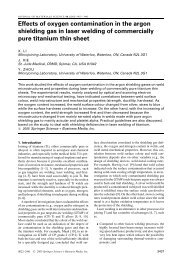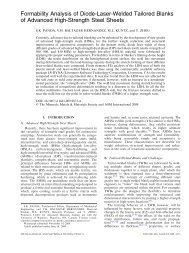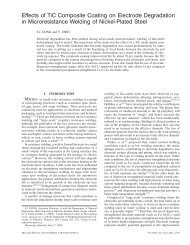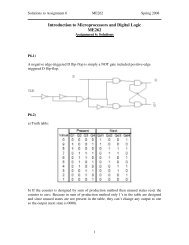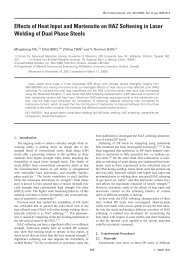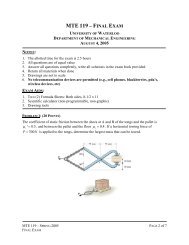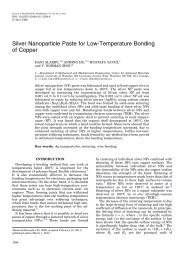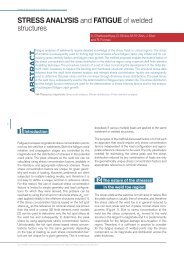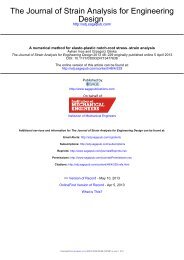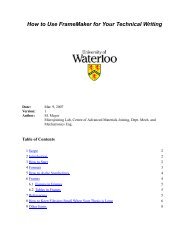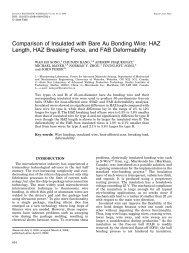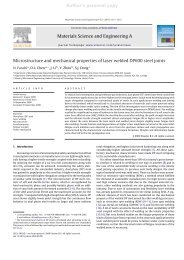Fabrication of a novel laser-processed NiTi shape memory ...
Fabrication of a novel laser-processed NiTi shape memory ...
Fabrication of a novel laser-processed NiTi shape memory ...
- No tags were found...
Create successful ePaper yourself
Turn your PDF publications into a flip-book with our unique Google optimized e-Paper software.
本 文 网 址 http://occr.christiantimes.org.hk/art_0085.htm第 3 页主 体 形 而 上 学 的 影 响 。 或 者 可 以 这 样 说 , 哈 莉 斯 的 人 观 正 正 就 反 映 了 主 体 形 而上 学 人 观 的 特 色 及 问 题 。( 三 ) 先 验 自 我 与 自 我 同 一 性 ─ 笛 卡 儿 与 康 德 的 主 体 形 而 上 学笛 卡 儿 ( R. Descartes )「 我 思 故 我 在 」( ‘Cogito ergo sum’ ) 的 提 出 , 正 式确 立 了 理 性 主 体 作 为 认 识 活 动 的 「 阿 基 米 德 基 点 」( Archimedian point ), 而这 个 认 识 活 动 基 础 点 之 确 立 实 有 赖 认 识 活 动 当 中 不 断 怀 疑 的 过 程 。 9 理 性 若 要获 得 普 遍 的 知 识 和 真 理 , 便 需 要 从 可 变 的 肉 体 和 感 官 世 界 中 撤 离 出 来 , 认 知 主体 不 断 对 由 肉 体 感 官 经 验 所 获 得 的 知 识 加 以 怀 疑 。 惟 有 从 可 感 变 幻 的 物 质 世 界中 抽 离 出 来 , 才 能 保 证 知 识 的 客 观 性 和 普 遍 性 。 因 此 , 惟 有 非 时 空 性 非 物 质 性的 纯 粹 自 我 思 维 意 识 才 是 连 接 真 理 的 接 触 点 , 10 这 种 认 知 主 体 是 不 具 内 容 的 纯形 式 的 先 验 性 自 我 , 是 一 种 纯 粹 自 我 意 识 的 精 神 实 体 。 胡 塞 尔 ( E. Husserl )认 为 笛 卡 儿 的 哲 学 进 路 , 便 是 沿 着 先 回 归 先 验 性 自 我 , 然 后 再 往 外 在 世 界 推 演的 方 向 前 进 的 。 11 换 言 之 , 那 些 实 证 科 学 的 客 观 领 域 便 是 需 要 依 赖 纯 粹 我 思 活动 主 体 的 自 我 推 演 出 来 。 毫 无 疑 问 , 胡 塞 尔 认 为 笛 卡 儿 将 自 我 界 定 为 不 具 时 空性 物 质 性 的 先 验 自 我 是 绝 对 正 确 的 。 纯 形 式 的 先 验 自 我 先 于 具 内 容 的 经 验 自 我而 存 在 , 由 于 前 者 不 具 任 何 可 感 变 幻 的 内 容 , 所 以 先 验 自 我 一 定 具 有 一 种 相 当稳 定 的 自 我 同 一 性 。在 自 我 同 一 性 的 问 题 上 , 休 谟 ( D. Hume ) 有 不 同 的 看 法 。 他 在 其 《 人 性论 》( A Treatise <strong>of</strong> Human Nature ) 中 对 先 验 自 我 及 依 其 所 建 构 的 自 我 同 一 性提 出 怀 疑 。 12 在 休 谟 这 种 连 自 我 存 在 也 值 得 怀 疑 的 怀 疑 主 义 冲 击 底 下 , 康 德( I. Kant ) 认 为 自 我 同 一 性 的 问 题 似 乎 不 能 完 全 往 经 验 主 义 处 寻 找 答 案 。 他 综合 了 理 性 主 义 与 经 验 主 义 的 立 场 , 从 先 验 哲 学 的 进 路 去 建 构 他 的 人 观 或 自 我观 。 他 肯 定 自 我 不 是 一 种 经 验 对 象 的 观 念 , 自 我 本 身 不 是 经 验 现 象 , 而 是 构 筑现 象 世 界 的 先 验 主 体 。 康 德 将 先 验 主 体 规 定 为 纯 粹 不 变 的 意 识 , 是 一 个 常 住 不9他 称 这 种 知 识 论 上 的 怀 疑 并 非 最 终 要 建 立 绝 对 怀 疑 主 义 , 它 只 是 一 种 「 方 法 上 的 怀 疑 」(methodical doubt)。10正 如 笛 卡 儿 自 己 所 言 :「 我 就 小 心 地 考 察 我 是 什 么 , 发 现 我 可 以 设 想 我 没 有 身 体 , 可 以 设 想 没有 我 所 在 的 世 界 , 也 没 有 我 所 在 的 地 点 , 但 是 我 不 能 就 此 设 想 我 不 存 在 … 由 此 我 认 识 到 , 我 是一 个 实 体 , 这 个 实 体 的 全 部 本 质 或 本 性 只 是 思 想 , 它 不 需 要 任 何 地 点 以 便 存 在 , 也 不 依 赖 于 任 何物 质 性 的 东 西 。」 笛 卡 儿 ,《 谈 方 法 》,VI。 引 自 《 十 六 — 十 八 世 纪 西 欧 各 国 哲 学 》, 北 京 大 学哲 学 系 外 国 哲 学 史 教 研 室 编 译 , 北 京 : 商 务 印 书 馆 ,1975, 页 148。11胡 塞 尔 写 道 :「 世 界 的 存 在 从 一 开 始 时 就 必 定 是 不 可 接 受 的 。 这 个 沈 思 者 只 是 使 自 己 做 为 他 的我 思 活 动 的 纯 粹 自 我 , 做 为 具 有 绝 对 不 可 怀 疑 的 实 存 , 做 为 某 种 不 能 被 扬 弃 的 东 西 — 某 种 即 使这 个 世 界 不 存 在 , 它 还 会 存 在 的 东 西 。 如 此 , 化 约 之 后 , 自 我 就 进 行 着 一 种 唯 我 论 的 (solipsistic)哲 学 化 活 动 。 他 寻 找 在 逻 辑 上 确 然 的 途 径 , 通 过 这 些 途 径 , 一 种 客 观 的 外 在 性 就 能 够 从 他 自 己 的纯 粹 内 在 性 中 被 推 演 出 来 。」 参 胡 塞 尔 ,《 笛 卡 儿 的 沈 思 》, 张 宪 译 , 台 北 : 桂 冠 ,1992, 页3。12按 照 休 谟 的 意 思 , 产 生 每 一 个 实 在 观 念 的 , 必 然 是 某 一 个 印 象 。 基 于 此 , 如 果 「 自 我 」 作 为 一个 观 念 , 则 肯 定 这 「 自 我 」 观 念 必 然 来 自 印 象 。 又 假 设 自 我 被 要 求 必 然 以 同 一 不 变 的 方 式 存 在 ,即 是 说 任 何 产 生 「 自 我 」 观 念 的 印 象 在 人 一 生 的 过 程 中 必 需 要 保 持 一 种 同 一 性 , 但 休 谟 说 并 没 有任 何 恒 定 而 不 变 的 印 象 , 因 此 , 也 就 没 有 一 个 恒 定 而 不 变 的 自 我 观 念 。 休 谟 所 质 疑 的 是 先 验 自 我在 本 体 论 上 作 为 一 切 知 觉 印 象 的 存 在 基 础 是 不 可 能 的 , 因 而 依 赖 这 种 存 在 基 础 而 出 现 的 自 我 同 一性 也 是 不 可 能 的 。 自 我 同 一 性 只 是 我 们 某 种 渴 求 同 一 稳 定 的 心 理 需 要 而 对 各 种 知 觉 印 象 想 象 或 虚构 出 来 的 性 质 而 已 , 从 彻 底 的 经 验 主 义 出 发 , 根 本 就 没 有 自 我 这 种 形 而 上 的 实 体 存 在 。
Daly et al. 5above the A f temperature. Therefore, the retention <strong>of</strong>stress-induced martensite upon unloading <strong>of</strong> <strong>laser</strong><strong>processed</strong><strong>NiTi</strong> samples was not unexpected. Furtherinvestigation is required, however, to better understandthe effects <strong>of</strong> <strong>laser</strong> processing on microstructure andcorresponding thermomechanical response in retainedbase metal.Figure 5(a) provides the captured data for the thermomechanicalrecoveries <strong>of</strong> the <strong>laser</strong>-<strong>processed</strong> tensilespecimens shown in Figure 4. As predicted by DSCresults, each microgripper component exhibited anindependent recovery at different temperatures. Whilethere was a slight overlap between recoveries <strong>of</strong> the secondand third thermomechanical responses, the lowertemperature material domain (second microgripper segment)recovered by approximately 90% before activation<strong>of</strong> the microgripper head. Temperaturescorresponding with the onset <strong>of</strong> thermomechanicalrecovery (A s ) correlated very well with the phase transformationonset temperatures determined from DSCtesting. The A f temperatures, however, were slightlyhigher than anticipated. This discrepancy can beexplained by thermal sinking to the tensile grips. Acomplete recovery was therefore slightly hindered inportions <strong>of</strong> the <strong>laser</strong>-<strong>processed</strong> samples that were inclose proximity to the gripping point.Thermomechanical Recovery (%)10080604020010080604020(a)(b)A s1A s2A f1Gripper HeadSecond SegmentA f2A s3020 40 60 80 100Temperature ( ◦ C)A f3First SegmentFirstSecondThirdFigure 5. (a) Thermomechanical recovery <strong>of</strong> eachmicrogripper component and (b) the combined recovery <strong>of</strong> the<strong>laser</strong>-<strong>processed</strong> <strong>NiTi</strong> microgripper.As shown in Figure 5(b), the recovery <strong>of</strong> the <strong>laser</strong><strong>processed</strong><strong>NiTi</strong> microgripper occurred in three stages.Upon heating to temperatures above A s1 , the specimenunderwent recovery <strong>of</strong> the first <strong>laser</strong>-<strong>processed</strong> positioningsegment. Further heating sequentially activated theremaining embedded thermomechanical behaviors.Actuation <strong>of</strong> the microgripper head was identified fromthe data set by the change in inflection <strong>of</strong> the microgripper’sthermomechanical response and comparison tothe individual responses provided in Figure 5(a). Incontrast to its individual response, recovery in the <strong>laser</strong><strong>processed</strong>microgripper specimen correlated well withDSC results, which was attributed to the processingdimensions <strong>of</strong> the tensile specimen (Figure 1(a)). Sincethe microgripper head segment was not in direct contactwith the tensile grips during thermomechanical characterization,thermal sinking did not occur.It was initially anticipated that the microgripperhead would account for 50% <strong>of</strong> the overall thermomechanicalrecovery because <strong>of</strong> its proportionally largerprocessing dimensions. Since the amount <strong>of</strong> detwinnedmartensite in <strong>NiTi</strong> determines the magnitude <strong>of</strong> <strong>shape</strong><strong>memory</strong> recovery (Miyazaki et al., 1984), and consideringthe different stiffnesses <strong>of</strong> <strong>laser</strong>-<strong>processed</strong> microgrippercomponents, a lessened response from themicrogripper head was understandable. In contrast, thethermomechanical response <strong>of</strong> the first microgrippersegment represented approximately 45% <strong>of</strong> the overallmicrogripper recovery, despite being only 25% <strong>of</strong> itsactive length. Future studies are planned to furtherinvestigate the complex mechanical relationshipsbetween <strong>laser</strong>-<strong>processed</strong> material domains.Deployment <strong>of</strong> the <strong>laser</strong>-<strong>processed</strong> microgripperUsing the DSC and thermomechanical recovery resultsas a guideline, a heating pr<strong>of</strong>ile was designed to sequentiallyactivate each <strong>of</strong> the three <strong>processed</strong> microgrippercomponents. Figure 6 provides photographs <strong>of</strong> each <strong>of</strong>the four positions achieved by heating the <strong>laser</strong><strong>processed</strong>microgripper along with the measured wiretemperature and electrical resistivity pr<strong>of</strong>iles. As anticipated,recorded temperatures did not explicitly matchwith the DSC data because <strong>of</strong> external loads imposedon the device from fixturing and also from the heatsinkingeffects <strong>of</strong> the temperature sensor. In order toconfirm sequential phase transformations in the <strong>laser</strong><strong>processed</strong><strong>NiTi</strong> microgripper, optical observations werecorrelated with in situ resistivity measurements.According to the trends reported by Kakeshita et al.(1998), sudden increases in the bulk resistance <strong>of</strong>solution-treated <strong>NiTi</strong> are indicative <strong>of</strong> a martensite toaustenite phase change. While it was expected that the<strong>NiTi</strong> material would show some increase in resistivitydue to heating, the increase in the magnitude <strong>of</strong> resistancein the microgripper could not be explained byjoule heating alone. The captured resistivityDownloaded from jim.sagepub.com at UNIV OF WATERLOO on May 7, 2012
6 Journal <strong>of</strong> Intelligent Material Systems and Structures 0(0)Figure 6. (a–d) Photographs <strong>of</strong> the <strong>laser</strong>-<strong>processed</strong> <strong>NiTi</strong> microgripper during sequential activation <strong>of</strong> each embedded <strong>shape</strong><strong>memory</strong> response and (e) collected in situ temperature and resistance measurements.measurements and photographs therefore confirmedthe localized phase changes and sequential activation<strong>of</strong> embedded thermomechanical domains in the <strong>laser</strong><strong>processed</strong>microgripper.While this study has demonstrated the enhanced capabilities<strong>of</strong> a simple <strong>NiTi</strong> microgripper, it is anticipatedthat <strong>laser</strong> processing can be used to embed added functionalityin the more elaborate microgripper designs currentlyavailable (Kohl et al., 2000; Lee et al., 1996).Furthermore, it is expected that the pseudoelastic response<strong>of</strong> the retained base metal can be exploited to deliver areversible thermomechanical recovery. A detailed investigation<strong>of</strong> the energy storage capabilities <strong>of</strong> retained pseudoelasticityis therefore planned for future research.ConclusionIn this study, a <strong>novel</strong> <strong>NiTi</strong> microgripper capable <strong>of</strong>self-positioning was fabricated through the application<strong>of</strong> <strong>laser</strong> processing with MMM technology. The effectsDownloaded from jim.sagepub.com at UNIV OF WATERLOO on May 7, 2012
Daly et al. 7<strong>of</strong> <strong>laser</strong> processing removed the prior training <strong>of</strong> theas-received alloy and considerably altered its thermomechanicalcharacteristics. Results from DSC testingshowed three independent material domains withunique austenite onset temperatures <strong>of</strong> 21°C, 48°C, and71°C, respectively. The three material domains werelocally embedded as the active components <strong>of</strong> a <strong>NiTi</strong>microgripper. The two lower temperature domainswere utilized as the self-positioning microgripper segments,while the higher temperature domain actuatedthe microgripper head. Mechanical testing revealedthree separate thermomechanical behaviors in the<strong>laser</strong>-<strong>processed</strong> microgripper which corresponded tothe independent <strong>shape</strong> <strong>memory</strong> recoveries <strong>of</strong> eachembedded material characteristic. Resistive heating <strong>of</strong>the <strong>NiTi</strong> microgripper permitted a visual confirmation<strong>of</strong> the sequential thermal activation <strong>of</strong> each <strong>laser</strong><strong>processed</strong>microgripper component.AcknowledgementThe authors would like to acknowledge Memry Corporationfor providing the <strong>NiTi</strong> material used in this study.FundingThis research was funded in part by the Natural Sciences andEngineering Research Council <strong>of</strong> Canada (www.nserc.ca).ReferencesBianchi G and Sorrentino R (2007) Electronic Filter Simulationand Design. New York: McGraw-Hill.Daly M, Pequegnat A, Khan MI, et al. (2011) <strong>Fabrication</strong> <strong>of</strong>a <strong>novel</strong> monolithic <strong>NiTi</strong> based <strong>shape</strong> <strong>memory</strong> microgrippervia multiple <strong>memory</strong> material processing. In: Proceedings<strong>of</strong> the ASME conference on smart materials, adaptive structuresand intelligent systems (SMASIS), Phoenix, AZ, 18–21 September 2011.Daly M, Pequegnat A, Zhou Y, et al. (2012) Enhanced thermomechanicalfunctionality <strong>of</strong> a <strong>laser</strong> <strong>processed</strong> hybrid<strong>NiTi</strong>-<strong>NiTi</strong>Cu <strong>shape</strong> <strong>memory</strong> alloy. Smart Materials andStructures 21: 045018.Duerig T, Pelton A and Stöckel D (1999) An overview <strong>of</strong> nitinolmedical applications. Materials Science and Engineering:A 273: 149–160.Fu Y, Huang W, Du H, et al. (2001) Characterization <strong>of</strong> TiNi<strong>shape</strong>-<strong>memory</strong> alloy thin films for MEMS applications.Surface and Coatings Technology 145(1–3): 107–112.Grossmann C, Frenzel J, Sampath V, et al. (2008) Processingand property assessment <strong>of</strong> <strong>NiTi</strong> and <strong>NiTi</strong>Cu <strong>shape</strong> <strong>memory</strong>actuator springs. Materialwissenschaft und Werkst<strong>of</strong>ftechnik39(8): 499–510.Hartl D and Lagoudas D (2007) Aerospace applications <strong>of</strong><strong>shape</strong> <strong>memory</strong> alloys. Proceedings <strong>of</strong> the Institution <strong>of</strong>Mechanical Engineers, Part G: Journal <strong>of</strong> Aerospace Engineering221(4): 535–552.Kakeshita T, Fukuda T, Tetsukawa H, et al. (1998) Negativetemperature coefficient <strong>of</strong> electrical resistivity in B2-TypeTi-Ni alloys. Japanese Journal <strong>of</strong> Applied Physics 37(1):2535–2539.Khan MI (2010) Pulsed Nd:YAG <strong>laser</strong> processing <strong>of</strong> nitinol.PhD Thesis, University <strong>of</strong> Waterloo, Waterloo, ON,Canada.Khan MI and Zhou Y (2010a) Effects <strong>of</strong> local phase conversionon the tensile loading <strong>of</strong> pulsed Nd:YAG <strong>laser</strong> <strong>processed</strong>nitinol. Materials Science and Engineering: A527(23): 6235–6238.Khan MI and Zhou YN (2010b) A method to locally modify<strong>shape</strong> <strong>memory</strong> and pseudoelastic properties. In: D. S.Grummon, X. Fei, M. R. Mitchell, M. Mertmann (eds)The international conference on <strong>shape</strong> <strong>memory</strong> and superelastictechnologies (SMST Extended Abstracts). PacificGrove, CA, 16–20 May 2010, pp. 202–203. ExtendedAbstract.Khan MI and Zhou YN (2011) Methods and systems for processingmaterials, including <strong>shape</strong> <strong>memory</strong> materials.World Intellectual Property Organization (WIPO) PatentApplication WO/2011/014962.Khan MI, Panda S and Zhou Y (2008) Effects <strong>of</strong> weldingparameters on the mechanical performance <strong>of</strong> <strong>laser</strong> weldednitinol. Materials Transactions 49(11): 2702–2708.Kohl M (2004) Shape Memory Microactuators. Berlin, Heidelberg:Springer-Verlag, Chapter 6.Kohl M, Just E, Pfleging W, et al. (2000) SMA microgripperwith integrated antagonism. Sensors and Actuators A:Physical 83(1–3): 208–213.Lee A, Ciarlo D, Krulevitch P, et al. (1996) A practical microgripperby fine alignment, eutectic bonding and SMAactuation. Sensors and Actuators A: Physical 54(1–3):755–759.Liu Y and Galvin S (1997) Criteria for pseudoelasticity innear-equiatomic <strong>NiTi</strong> <strong>shape</strong> <strong>memory</strong> alloys. Acta Materialia45(11): 4431–4439.Miller D and Lagoudas D (2001) Influence <strong>of</strong> cold work andheat treatment on the <strong>shape</strong> <strong>memory</strong> effect and plasticstrain development <strong>of</strong> <strong>NiTi</strong>. Materials Science and Engineering:A 308(1–2): 161–175.Miyazaki S, Kimura S, Otsuka K, et al. (1984) The habitplane and transformation strains associated with the martensitictransformation in Ti-Ni single crystals. ScriptaMetallurgica 18(9): 883–888.Miyazaki S, Otsuka K and Suzuki Y (1981) Transformationpseudoelasticity and deformation behavior in a Ti-50.6at.% Ni Alloy. Scripta Metallurgica 15(3): 287–292.Pequegnat A, Vlascov M, Daly M, et al. (2011) Dynamicactuation <strong>of</strong> a multiple <strong>memory</strong> material <strong>processed</strong> nitinollinear actuator. In: Proceedings <strong>of</strong> the ASME conferenceon smart materials, adaptive structures and intelligent systems(SMASIS), Phoenix, AZ, 18–21 September 2011.Sˇittner P, Liu Y and Novák V (2005) On the origin <strong>of</strong>Lu¨ders-like deformation <strong>of</strong> <strong>NiTi</strong> <strong>shape</strong> <strong>memory</strong> alloys.Journal <strong>of</strong> the Mechanics and Physics <strong>of</strong> Solids 53(8):1719–1746.Tam B (2010) Micro-Welding <strong>of</strong> nitinol <strong>shape</strong> <strong>memory</strong> alloy.MASc Thesis, University <strong>of</strong> Waterloo, Waterloo, ON,Canada.Tang W (1997) Thermodynamic study <strong>of</strong> the low temperaturephase B19’ and the martensitic transformation in nearequiatomicTi-Ni <strong>shape</strong> <strong>memory</strong> alloys. Metallurgical andMaterials Transactions A 28(3): 537–544.Downloaded from jim.sagepub.com at UNIV OF WATERLOO on May 7, 2012



